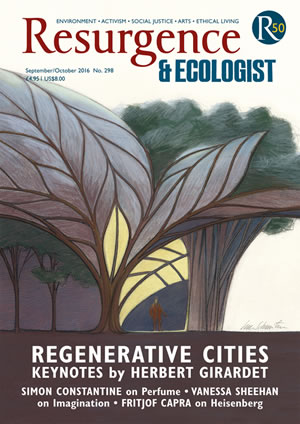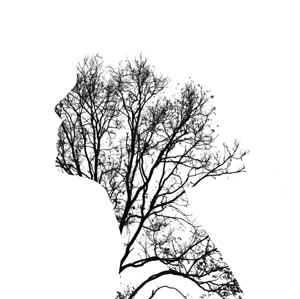“The tree which moves some to tears of joy is in the eyes of others only a green thing that stands in the way. Some see Nature all ridicule and deformity… and some scarce see Nature at all. But to the eyes of the man of imagination, Nature is imagination itself.” – William Blake
Thomas Berry said that loss of imagination is loss of Nature. This poses the question: what is the link between imagination and Nature? Could the human imagination have an ecological function? Of course, the source of all creative action and novelty is the imagination. The etymology of the word ‘Nature’ (Latin natura) means ‘birth’. Might the Earth and all her diverse forms therefore be considered a material birthing of a planetary imagination, which constitutes a transcendental wholeness, an intelligent, novelty-producing urge to life?
In this context we humans are not born onto the Earth; rather we are birthed by the Earth. Each of us embodies a spark, a part, of this transcendental wholeness in which we are simultaneously embedded and implicated, both psychically and physically. The mental and material structure of the human is rooted in the mental and material structure of our planet. Human and Earth thus constitute a coherence. Here the whole is present within the part.
In light of such a coherence, might it be that the macrocosmic imagination of the Earth, that novelty-producing urge to life, which seems to creatively unfold itself sensuously, is present in our own microcosmic psyche and imagination? Ultimately, as humans, are we thus born with the capacity to channel the same intelligence that flows through Nature in imaginal reverie and give it intentional expression through our own creativity? In understanding that we are embedded parts of a planetary-sized ecological system, can we learn to design from our imagination in such a way that our acts of creation contribute to ecological diversity and renewal of life?
Humans appear to be unique in that we are the only creatures who have the ability to create imagined alternative futures using symbolic language. Therefore it may be that humans, as expressions of Earth’s growing complexity, are assisting the Earth in imagining its own future through the faculty of their imaginations. What is significant about this is that human creativity is as great as any geological force this planet has ever displayed. It is for this reason that the capacity for humans to imagine, on behalf of and in solidarity with the Earth, and actively participate in supporting ecological integrity for the future has far greater consequences than ever before. Human imagination is now an imperative for a global symbiosis to re-establish itself between Nature and human culture.
It has been claimed by generations of mystics, poets and Indigenous people that the human imagination is a medium for communication with the divine intelligence. Therefore imagination is used to receive guidance, disclose something of the mystery in which each individual participates, and ensure that harmony is established between people and the divine and people and Nature, as well as between part and whole. The mystics and poets relate to the transcendental intelligence through altered states of consciousness – by bringing themselves to the edge of their unconscious in such states as dreaming, praying, meditating, dancing and singing. From these people’s practices, we might then best understand the imagination as a paradoxical point between our conscious and unconscious. This state facilitates a co-creative potential to arise between part and whole, self and other.
“With our imagination we dream the world into being; it is something we carry between us and the world, not inside us.” – David Abram
The mechanistic philosophy dominant in our present culture is founded on the reductionist paradigm that separates mind and matter, Spirit and Nature. When Descartes stipulated this distinction in the 17th century, the imagination suffered something of a displacement and got caught in a duality with rationality. Creativity was thus no longer considered an act of conspiring with the divine wisdom of Nature to achieve cooperation and symbiosis. Rather, Nature became a mechanical resource for exploitation and manipulation. In essence, the harmonic wholeness individuals strove to manifest in their actions was lost to a different agenda – one where Nature’s creative principles were compromised in pursuit of a human-centred culture that promoted individualism and competition.
What has been lost as a result of this Cartesian dualism is both a desire for and legitimacy in pursuing and entering into a communion with ‘the transcendental other’ that resides in Nature’s interiority. Such communion unfolds as a journey of engagement in the material world, arising through reverie, connection and devotion. When this communion and engagement are regarded as nonsensical, even our psychological connection with Nature is closed.
We are amphibious creatures, deeply in need of both realms, physical and metaphysical. This is not to trade matter for mind, or science for spirituality. Rather it is to transcend these dichotomies. The planet’s living, intelligent creativity is able to reveal something of itself to us, through us. We need to allow our imaginative encounters to remind us that we are embedded experientially and subjectively in a larger coherence of Nature. Remaining only in the intellectual understanding of the planet has caused us to forget the imperative for a wise and ethical application of our imagination and creativity; and because of this reductionist approach we are no longer able to consider the whole or indeed ‘the other’ in our creative actions.
Humans have become a vast planetary metabolism. It seems that we no longer have any reference point of where to go next in order to address the massive complexity of our social-ecological crises. Therefore we need to stimulate the imagination in order to address these problems, which require something else other than knowledge. In order for our imagination to breed symbiotic creativity with Nature, we might start by following the wisdom of artists, visionaries, mystics and Indigenous peoples, such as Mozart, William Blake, Leonardo da Vinci, Carl Jung and Rumi. We may need to seek guidance from the transcendental wholeness where the ‘I’ dissolves into the ‘Thou’.
“What can I contribute with my unique creativity to the Earth?” The answer may be found in dreams, meditation, prayer, dance, and artistic expression. This may be a way to court the planetary imagination and position ourselves in conversational dynamics with Nature. Creatives take time to move out of their conscious mind and go into the depths of imagination with sympathy, humility and compassion in order to be guided by all of those symbols and messages.
Imagination and Nature are linked by the way in which the imagination enables us to experience a quality of connection and encounter with that transcendental urge to life. When we see Nature and all Earthly beings as the material birthing of a planetary imagination, we resolve the sense of separation between humans and Nature. By engaging imaginatively with Nature, a coherency between Nature and human creativity is harnessed, enabling us to base our actions on an ethic of mutual respect and interdependence.







